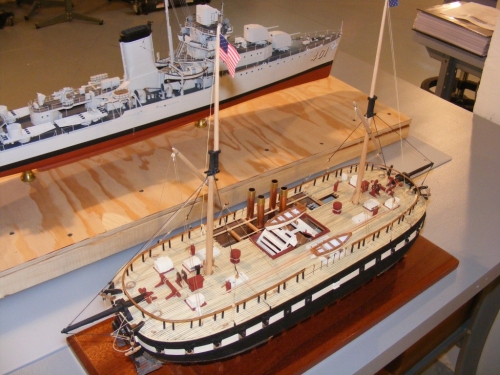Fulton’s Demologos (1813 preliminary design).
During the final months of the War of 1812 against Britain, the United States made the first use of a steamship in a military campaign and also laid down the world’s first steam-powered warship. In January 1815 General Andrew Jackson used the Mississippi river steamer Enterprise to transport troops and supplies and to carry dispatches before the Battle of New Orleans. Meanwhile, the American steamship pioneer Robert Fulton, whose earlier river boat Clermont (1807) was the first commercially successful merchant steamer, in June 1814 laid down the steam warship Demologos at New York. The innovative 1,450-ton vessel was designed to defend New York harbor against British ships of the line and frigates. It had a centerline paddle wheel between twin hulls, engines placed below the waterline capable of 5.5 knots, wooden “armor” five feet thick, and thirteen 32-pounders in each broadside. Fulton died shortly before the Demologos made its first sea trial in June 1815; by then the War of 1812 was over, and it was never commissioned. The last of three trials took place that September, after which it was laid up in reserve. The Demologos made only one further voyage under its own power, in 1817, when it ferried President James Monroe from New York to Staten Island. Its engines were removed in 1821 and it served as a receiving ship until it blew up in an accident in 1829.
In the years after 1815, a slow and subtle revolution in naval ordnance coincided with the gradual acceptance of the steamship as a potential warship. Except for Fulton’s Demologos and Cochrane’s Rising Star, the first generation of armed steamers consisted entirely of vessels with side paddles.
With anti-Mexican sentiment running high in the wake of Texas’ successful war for independence (1836), the United States chose not to invoke the Monroe Doctrine in defense of Mexico. If it had, the American navy may have been hard-pressed to do battle on even terms with Baudin’s squadron. After the engines were removed from the Demologos in 1821, the US navy was without an armed steamship until the 1,010-ton Fulton of 1837. This unsuccessful ship was in commission just five years before being laid up for a decade and eventually re-engined. Its failure may have set back the introduction of steam in the US navy if not for the sensation created by the maiden voyage of Isambard Brunel’s Great Western, which arrived in New York in April 1838. The 2,370-ton Atlantic liner was an excellent advertisement for steam power, built to naval standards and equipped with powerful engines, capable of steaming continuously for three weeks. It influenced the construction of large paddle steamers in the British, French, and American navies, the latter leading the way with the Missouri and the Mississippi, 3,220-ton warships designed by a committee chaired by the captain of the Fulton, Matthew C. Perry. Reflecting Paixhans’ concept of the future capital ship, upon their completion in 1842 they were armed with two 10-inch and eight 8-inch guns. The engines, a British-style side lever plant in the Mississippi, an American design in the Missouri, were built by Merrick and Towne, and were capable of almost 9 knots. The vessels were monuments to the progress of American industry but their domestic construction and components made them the most expensive warships of their era. Tragically the Missouri had a very short service life, burning accidentally at Gibraltar in 1843. The loss left the Mississippi as the navy’s only active steamer. Later in 1843, amid rumors of an impending British annexation of Hawaii, the United States defended its interests there by sending the United States and the Constellation, sailing frigates completed in 1797.
